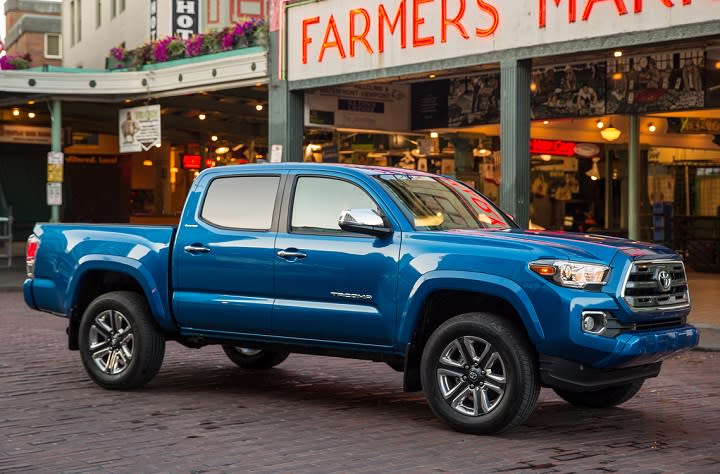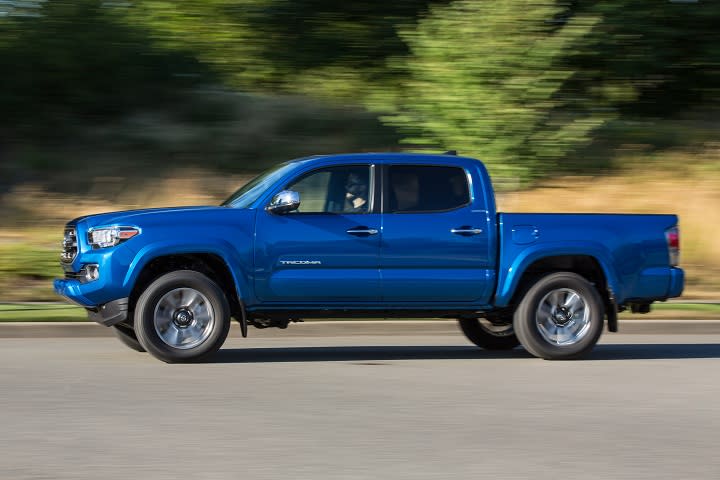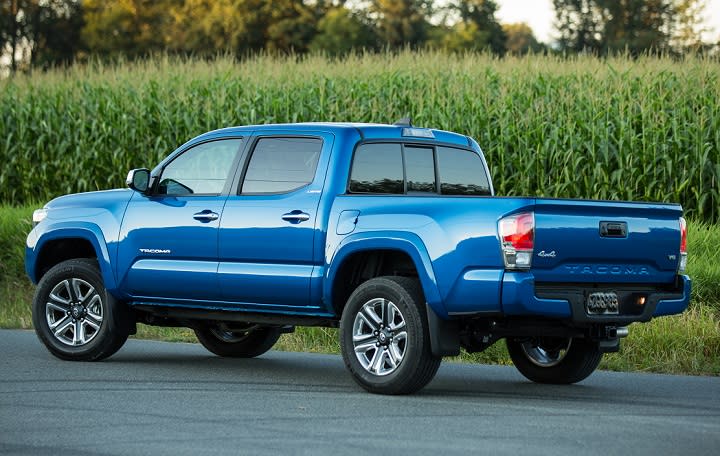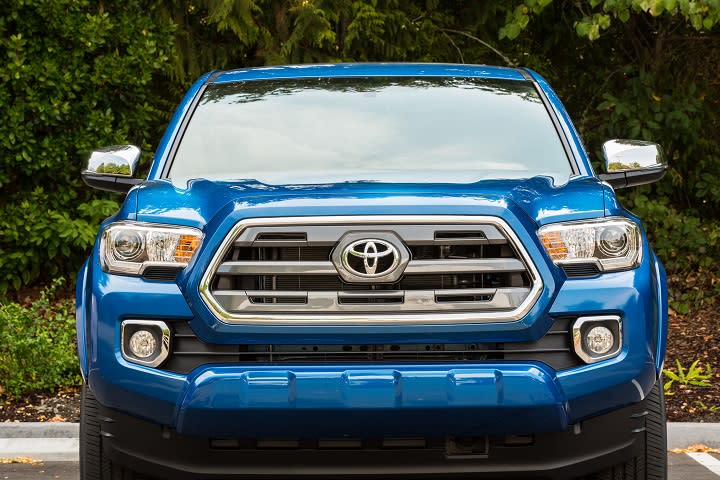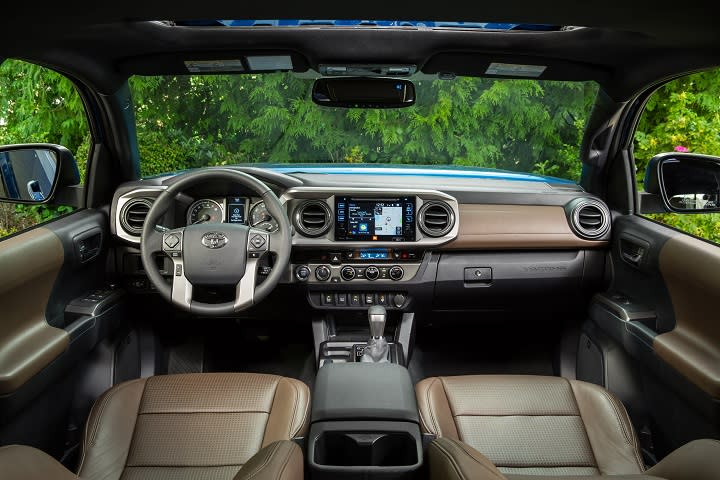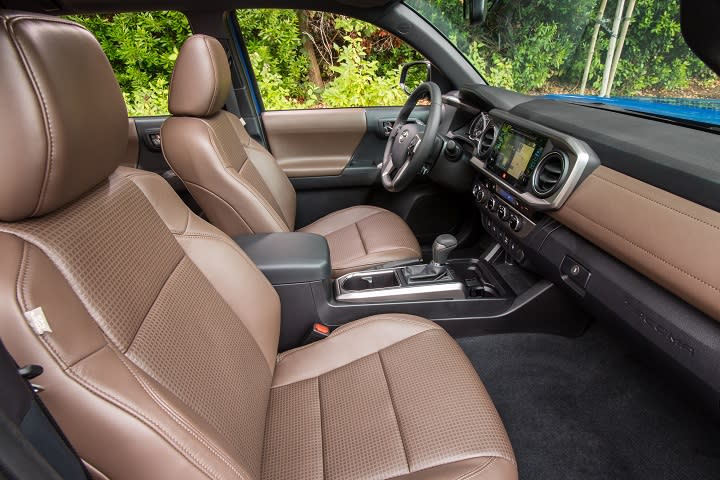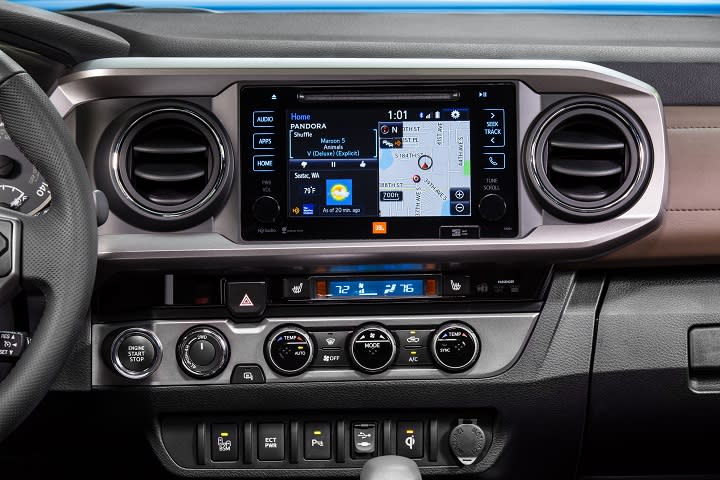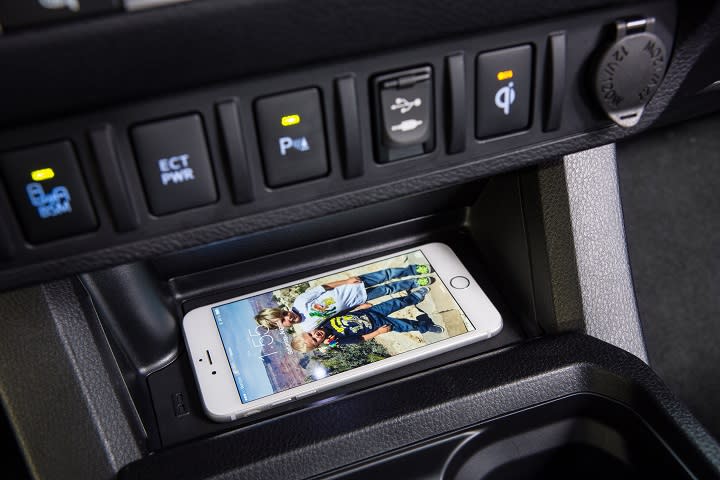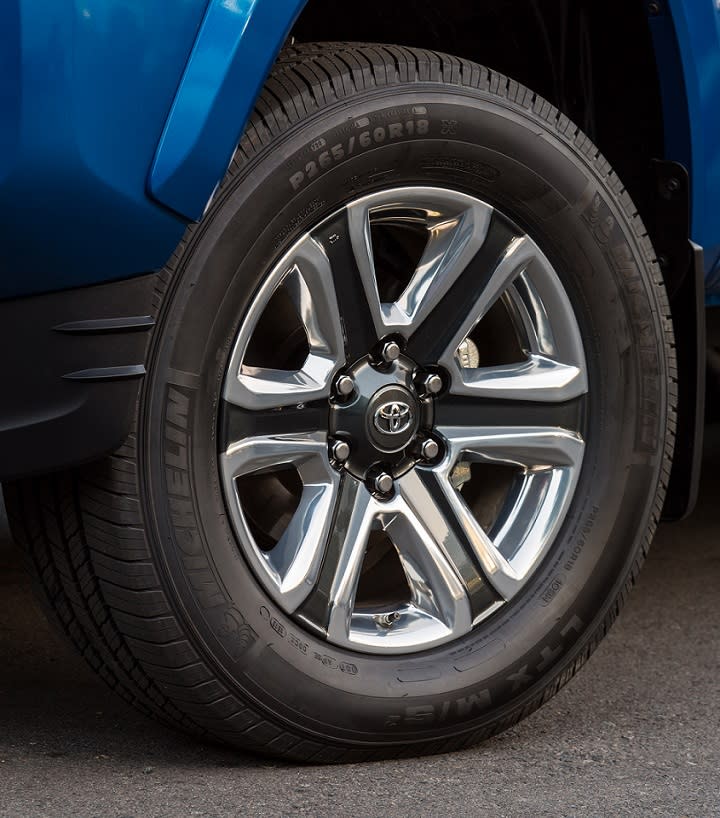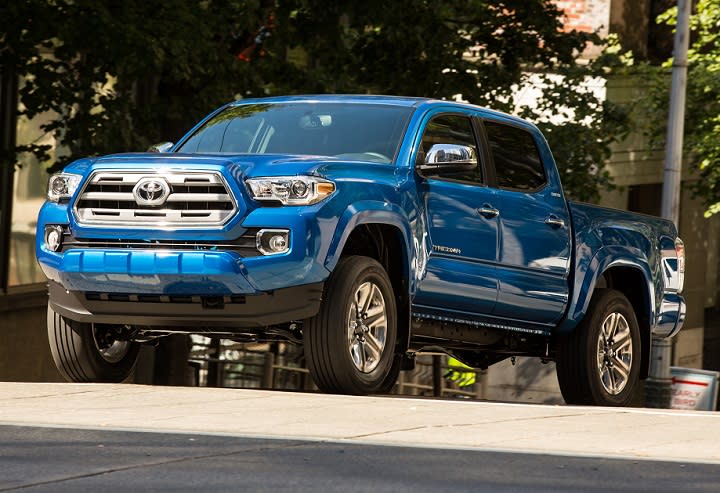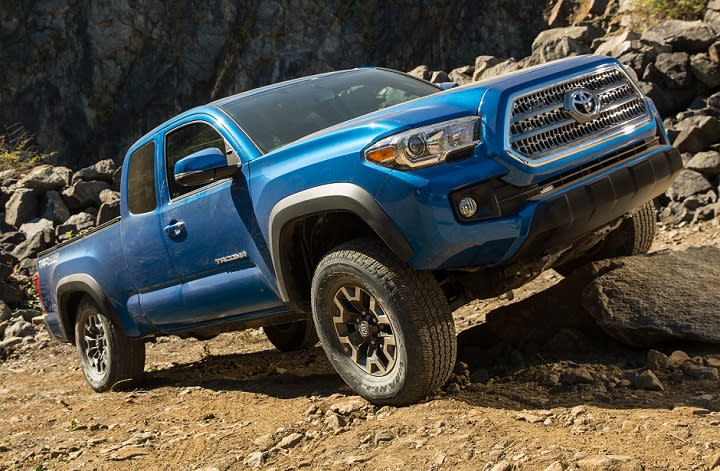PowerSteering: 2017 Toyota Tacoma Review
Body Style:
Abstract:
The Toyota Tacoma is plainly and clearly a truck, one built for difficult work and vigorous play, and it isn’t trying to be anything else. Read our PowerSteering review of the 2017 Tacoma...
Year:
2 017
2017 Toyota Tacoma Limited front quarter right photo Introduction
Toyota dominates midsize pickup truck sales. During the first quarter of 2017, the automaker sold almost twice as many Tacoma pickups as Chevrolet did Colorados. However, this sales performance does not align with the Tacoma’s performance in the J.D. Power 2016 U.S. Automotive Performance, Execution and Layout (APEAL) Study.SM Despite a complete redesign for 2016, the Tacoma ascended from its fourth-place, bottom-of-the-segment ranking in the 2015 APEAL Study to no higher than third in the 2016 APEAL Study.
To learn more about why this truck is so popular in spite of its apparent lack of appeal, we evaluated a 2017 Tacoma Double Cab Shortbed in TRD (Toyota Racing Development) Off-Road trim with 4-wheel drive (4WD), an automatic transmission, floor mats, tow package, and a Premium and Technology package. The price came to $38,974, including the $960 destination charge.2017 Toyota Tacoma Limited side profile photo What Owners Say
Before we discuss the results of our evaluation of the 2017 Tacoma, it’s helpful to understand who buys this pickup truck and what they like most and least about it.
The Midsize Pickup segment is not a large one, and last year just four models were available. In addition to the Tacoma, buyers could choose the Chevrolet Colorado, GMC Canyon, and the Nissan Frontier. Among this quartet, the Tacoma ranked third overall in the 2016 APEAL Study, behind the second-ranked GMC and highest-ranked Chevrolet.
Tacoma buyers are primarily men (87%), which matches the segment average. Their median age is 55 years (vs. 57 years) and their median household income is $96,471 (vs. $95,245). More Tacoma buyers identify themselves as price buyers (26% vs. 23%) or performance buyers (24% vs. 20%) than the segment average.
Expectedly, Tacoma buyers are less likely to prefer to buy a vehicle from a domestic company (44% vs. 57%). Additionally, they are slightly less likely to agree that their first consideration in choosing a vehicle is miles per gallon (60% vs. 62%), and they are slightly less likely to agree that they are willing to pay more for a vehicle that is environmentally friendly.
Styling matters more to Tacoma buyers, who are slightly more likely to agree that they like a vehicle that stands out from the crowd (80% vs. 77%). This aligns with the finding that just 32% of Tacoma buyers agree that a vehicle is just a way of getting from place to place (compared with 36%).
Buyers say their favorite things about the Tacoma are (in descending order) the exterior styling, interior design, driving dynamics, visibility and safety, and infotainment system. Buyers indicate their least favorite things about the Tacoma are (in descending order) the climate control system, storage and space, seats, engine/transmission, and fuel economy.2017 Toyota Tacoma Limited rear quarter left photo What Our Expert Says
In the sections that follow, our expert provides his own assessment of how the 2017 Toyota Tacoma performs in each of the 10 categories that comprise the 2016 U.S. APEAL Study.
2017 Toyota Tacoma Limited front photo Exterior
It doesn’t require a significant leap of faith to bet that guys like trucks that look like trucks. Since 87% of midsize pickup buyers are men, and this Toyota is an undeniably tough-looking rig, it doesn’t surprise me at all that exterior styling is reported by Tacoma buyers to be their favorite thing about the truck.
While driving the test vehicle in rural portions of California’s Ventura County it attracted plenty of attention, though this was almost certainly due in part to the Inferno orange paint. Personally, I find the Tacoma’s styling to be overwrought, almost cartoonish, and I can’t figure out why the TRD Sport and TRD Off-Road versions have a chrome grille while the upscale Limited gets a gray one.
Nevertheless, midsize pickup truck buyers clearly disagree with me on the styling, voting to that effect with their wallets and making the Tacoma by far the most popular model in its segment.2017 Toyota Tacoma Limited interior photo Interior
Tacoma buyers claim that interior design is their second most favorite thing about this truck. Again, I can understand this. Exhibiting a no-nonsense approach to cabin design, the Tacoma features a compelling blend of form and function rendered in durable, industrial-grade materials.
You’re not afraid to get this truck dirty, thanks in part to its “hose-me-out” ambience, and that means you’re not afraid to use it and abuse it.2017 Toyota Tacoma Limited rear seats photo Seats
No matter which Tacoma you buy, or how much you’re willing to spend, you cannot get a driver’s seat height adjuster for this truck. This omission makes it relatively easy to slide into and out of a Tacoma, especially if you’re tall. Once you’re in, though, you sit low and close to the floor, facing an oversized steering wheel with an obnoxiously thick rim, legs splayed as though you’re lounging on your living room couch. The seat itself is comfortable, though, if lacking in terms of thigh support.
Young children have trouble climbing aboard a Tacoma Double Cab, as reported by my kindergartener. Adults will find a rear-seat cushion that sits up high, in direct contrast to the front seat. In fact, rear passengers are perched tall enough that even people of modest stature may suffer restricted headroom.
Grown-ups won’t want to ride in the back seat in the first place. Legroom is quite tight, and while softly padded front seatbacks are helpful, my legs still straddled the driver’s seat even when it was in its second-to-last seat-track position. Furthermore, Toyota provides no air vents or power ports for rear-seat riders.2017 Toyota Tacoma Limited infotainment and climate control system photo Climate Control System/Infotainment System
Climate Control System
As part of the optional Premium and Technology package the test truck included a dual-zone automatic climate control system and heated front seats. The dual-zone system is easy to use and to reference, and is effective at cooling the interior on a hot day. Giant dashboard air vents make it easy to direct airflow.
Notably, when the power sunroof is open, the power-sliding rear window is open, and all side windows are lowered, driving and riding in the Tacoma is like being inside of a convertible, but without quite the same degree of exposure to UV radiation.Infotainment System
As standard equipment, the 2017 Tacoma TRD Off-Road is equipped with an Entune Premium infotainment system including App Suite and an embedded navigation system. It features a flush tablet-style surface, a 7-in. display, and both power/volume and station tuning knobs. Honda should take note of this design, even if I kept forgetting that I needed to press “Apps” in order to get to the main menu rather than “Home.”
It is easy to set up and use this system, and to pair an iPhone to the Bluetooth connection. The system includes voice recognition and is Siri-compatible, but if you want Apple CarPlay or Android Auto you’re out of luck. Also, the narrow, touch-sensing slivers that Toyota employs for favorite radio station pre-sets are often impossible to use with accuracy in a bouncy truck like this one.
The system does not provide natural-voice recognition. That means you can’t push the talk button and conversationally ask for directions to a specific restaurant in a particular city. However, if you’re patient enough to follow the prompts, it will understand you most of the time. When it doesn’t though, its time to ask Siri.2017 Toyota Tacoma TRD Sport center stack storage photo Storage and Space
Though the Tacoma’s traditional handbrake consumes plenty of space in the center console, Toyota still finds a way to provide a big tray, 6 cupholders, and a sizable storage bin. The large compartmentalized glove box is also a nice touch, but Toyota missed opportunities to carve out extra space in the door panels and/or dashboard.
Dropping the truck’s tailgate is easy, and it lowers slowly on dampened hinges. The test truck includes 4 adjustable tie-down cleats near the bed’s top rails, 4 hooks on the bottom of the bed, and a 115-volt power outlet on the right rear side of the bed.
Toyota offers a long list of accessories designed to improve the Tacoma’s ability to tow things and haul stuff. One key upgrade is a handy step that deploys to make it easier to climb into the bed.2017 Toyota Tacoma Limited headlight photo Visibility and Safety
Forward visibility is a problem in the Tacoma. The low seating position, combined with the long and flat hood, makes it harder to safely drive off-road on an unfamiliar trail. The windshield pillars are thick, too.
Otherwise, I had no trouble seeing out of the Tacoma. The large side mirrors and the test truck’s optional blind-spot warning system made lane changes easy, and a reversing camera with rear cross-traffic alert helped when backing the Tacoma down driveways and out of parking spaces. While the Tacoma is not available with adaptive cruise control, forward-collision warning, or lane-departure warning systems, I did not miss them. Automatic emergency braking, however, is overdue.
The National Highway Traffic Safety Administration (NHTSA) gave the Tacoma Double Cab a mix of 4- and 5-star (out of a possible 5) crash-test ratings, and it is worth noting that this high-riding truck earns a 4-star rating for its ability to resist a rollover. The Insurance Institute for Highway Safety (IIHS) had not completed testing on this truck as this review was published. The Tacoma did, however, earn top marks in the Institute’s finalized moderate overlap frontal-impact test and side-impact tests.2017 Toyota Tacoma Limited wheel photo Engine/Transmission/Fuel Economy
Relatively speaking, Tacoma buyers do not like this truck’s drivetrain, which must come as a shock to Toyota given that the top engine choice is a new and fairly sophisticated design.
A 2.7-liter 4-cylinder engine is available for the 2017 Tacoma, offered only for select SR and SR5 trim trucks. That means most people will buy one with the significantly more powerful 3.5-liter V-6 motor.
To maximize fuel economy as much as possible, the V-6 employs Atkinson-cycle combustion, direct fuel injection, and variable valve timing. It makes 278 horsepower at 6,000 rpm and 265 lb.-ft. of torque at 4,600 rpm, and is paired with a 6-speed manual or a 6-speed automatic transmission. As installed in the test truck, it was rated to carry 1,175 lbs. of payload and tow 6,400 lbs. of trailer.
Engine/TransmissionLike most pickup trucks, the engine powers the rear wheels. A 4WD system with high and low range is optional, and the TRD Off-Road test truck included an electronically controlled locking differential, hill-start assist, and Toyota’s Multi-Terrain Select and Crawl Control technology. Obviously, it is ready to go places where most other trucks cannot tread.
Though sophisticated, the V-6 is not particularly refined in terms of noise, vibration, and harshness, nor is it particularly fuel-efficient. It also can’t match the segment leaders in terms of towing and payload capacity. Step hard onto the accelerator pedal and the Tacoma literally roars to life and moves with a semblance of authority. But most of the time this truck is just loud and slow.
Shifting the gated transmission also takes some getting used to; at first, I kept inadvertently putting the truck into Sport driving mode. The automatic does hold a gear on a grade, helping the Tacoma to maintain speed and power up mountainsides.Fuel Economy
During testing on the standard loop, the Tacoma TRD Off-Road averaged 19.1 mpg. According to the EPA, the truck should have returned 20 mpg in combined driving.
2017 Toyota Tacoma Limited front quarter left photo Driving Dynamics
To understand the Tacoma TRD Off-Road’s driving dynamics you first must consider that this truck is equipped with variable hydraulic-assist rack-and-pinion steering, ventilated front disc and rear drum braking system, specially tuned Toyota Racing Development off-road suspension with Bilstein shocks, and 265/70R16 Kevlar-reinforced Goodyear Wrangler tires. Translated, this truck is built for dirt, not pavement.
Off-roading is the Tacoma TRD Off-Road’s reason for being, which makes the long hood and obscured forward visibility such a shame. Over crests on an unfamiliar trail, a Tacoma driver is forced to go slower and to stop frequently to examine the path ahead. With a generous approach angle and no silly side rails to get hung up on rocks, though, the Tacoma eagerly attacks tough terrain.
The trouble is that most of the time owners of this truck will be traveling on pavement, not dirt.
The steering is heavy and slow, supplying vague response to input. The brakes are difficult to modulate, displaying an irritating on-or-off trait when all the driver wants to do is to bleed some pressure in stop-and-go traffic or when threading down a country road. The ride quality is bouncy, but the Tacoma TRD Off-Road effortlessly pounds broken pavement into submission. At highway speeds, wind noise and the constant background thrum of the drivetrain can become tiring.
Handling is mighty unimpressive, the tires proving squishy on pavement and offering little in the way of confidence. This, combined with the grabby brakes and sloppy steering, keeps speeds low and slow. As a result, on the test loop, the Tacoma had no trouble executing a full-ABS panic stop after a long mountain descent, simply because the truck failed to instill the confidence necessary to bring speeds up to the point where hard brake use might possibly cause fade.2017 Toyota Tacoma TRD Off-Road front quarter right photo Final Impressions
There is a sense of simplicity, honesty, and authenticity to the Toyota Tacoma. It is plainly and clearly a truck, one built for difficult work and vigorous play, and it isn’t trying to be anything else. You get the sense that it will withstand significant abuse and last for what seems like forever.
At the same time, at least in TRD Off-Road trim and used in suburban California as a daily driver, it is soul-crushingly uninspiring to drive. Unless you plan regular adventuring well off of the beaten path, you will potentially be better served by a different version of the Tacoma.
At the very least, you might want to test drive a Chevy Colorado, GMC Canyon, or Honda Ridgeline before settling on Tacos for your steady automotive diet.
Toyota Motor Sales, U.S.A. supplied the vehicle used for this 2017 Tacoma review.
For more information about our test driver and our methodology, please see our reviewer profile.Additional Research:
Check this if this is NOT an Articles Listing Page:
New or Used:
New
Display Article Date?:
Fuel:
Article Is Flipbook:
Yes

 Yahoo Autos
Yahoo Autos 
